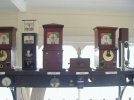The origin of the term 'peg' for signal lies in an old type of block instrument that required a peg to be inserted for certain operations to operate signals. Does not matter here exactly what it did, nor details of the devices, that differed from maker to maker.
The loose term 'peg' for a signal used on those railways with that type of pegging block instrument, and the term 'got the peg', really means the peg had been used on the block instrument - but was adopted for 'got the signal', in turn peg for signal, and probably corrupted over time, and distorted and misunderstood by enthusiasts.
It is not a term used everywhere, I agree, and, if you say not used on WR (and I can't say one way or the other) I suspect this will be because (G)WR maybe (question) not used that type of instrument ? You have to be careful about what staff as people move around from area to area and railway to railway. And railway Regions borders changes.
As peg is unofficial for a signal, one can not give any absolutely clear answer for region, be it previous BR operating region or geographical legacy.
Board must be pretty obvious ?
On top of all this, generally, there are many influences to unofficial names or official names, just like the current thread q.v. re signal box and signal cabin. And terms used by railway staff are not always, in fact quite often not, those used in the enthusiast world (e.g. 'duff' v. "four and a half" combines just about every variable I can think of.


